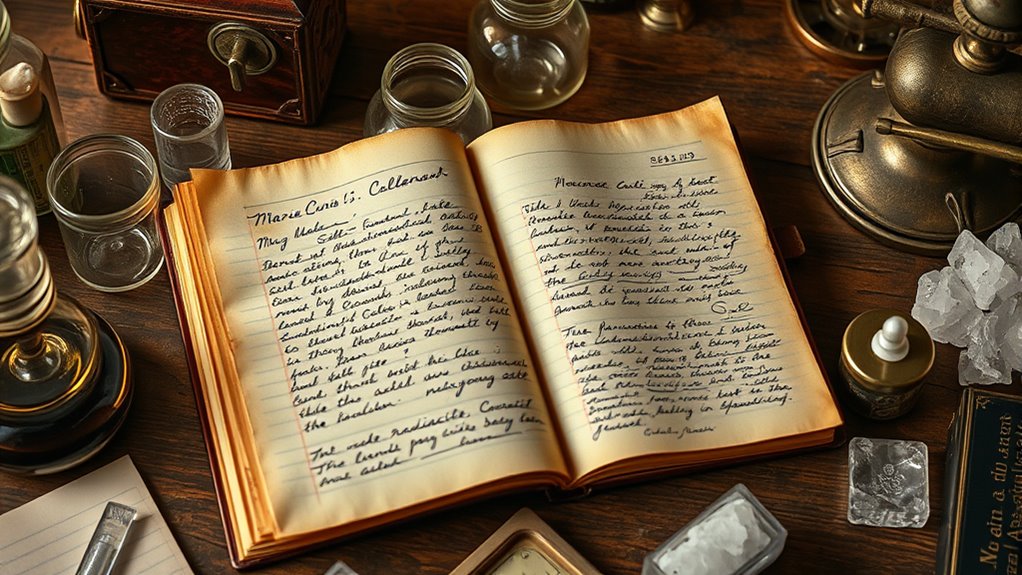Marie Curie’s laboratory notebook is like a radioactive time capsule that offers a rare glimpse into her groundbreaking experiments with radioactivity. It shows her meticulous notes on materials, measurements, and procedures, emphasizing accuracy and reproducibility. Her disciplined approach to systematic testing uncovered key properties of radioactive elements like polonium and radium. If you keep exploring, you’ll uncover how her persistent work revolutionized science and paved the way for modern discoveries in physics and medicine.
Key Takeaways
- The notebook offers detailed records of Marie Curie’s pioneering experiments in radioactivity.
- It showcases her meticulous methodology, emphasizing reproducibility and precise data collection.
- The journal documents her step-by-step procedures for isolating polonium and radium.
- It reveals her systematic approach, including noting anomalies and refining techniques over time.
- As a scientific archive, it exemplifies perseverance, disciplined inquiry, and groundbreaking discoveries in nuclear science.

Marie Curie’s laboratory notebook offers an invaluable glimpse into the groundbreaking experiments that shaped her discoveries in radioactivity. As you examine its pages, you’re transported back to a time when scientific inquiry was driven by curiosity, meticulous observation, and unwavering dedication. This notebook documents her pioneering work, where she systematically explored radioactive discoveries, laying the foundation for modern nuclear science. It’s more than just a record of experiments; it’s a testament to her scientific methodology, demonstrating how she approached complex problems with rigor and precision. You’ll notice her careful notations of the materials she used, precise measurements, and step-by-step procedures. These details reveal her disciplined approach to experimentation, emphasizing reproducibility and accuracy—cornerstones of scientific methodology. Curie didn’t rely on guesswork; instead, she designed experiments to test hypotheses and verify results. Her notebook captures this methodical process, showing how she isolated radioactive elements like polonium and radium through repeated testing and analysis. Each page reflects her commitment to understanding the nature of radioactivity, not just discovering it but exploring its properties systematically. As you read her notes, you observe how Curie’s discoveries weren’t accidental—they were the result of persistent inquiry and disciplined scientific practices. She meticulously recorded data, noting variations and anomalies, which helped her refine her experiments. This approach allowed her to identify key characteristics of radioactive substances, such as their emission of particles and energy. Her detailed observations provided the basis for later scientific breakthroughs, including understanding that radioactivity was an atomic phenomenon rather than a chemical one. This shift in perspective was revolutionary and exemplifies her adherence to rigorous scientific methodology. The notebook also reveals her perseverance amid challenges. She often documented failed experiments, demonstrating her understanding that setbacks are part of scientific progress. Her systematic approach enabled her to build upon previous findings, gradually unraveling the mysteries of radioactivity. By carefully analyzing her data, she established reproducible methods that others could follow, cementing her role as a pioneer in science. Her work exemplifies how disciplined methodology and persistent inquiry lead to transformative discoveries. Ultimately, Marie Curie’s laboratory notebook isn’t just a collection of scientific notes; it’s a vivid archive of a scientific revolution. It highlights the importance of scientific methodology in achieving groundbreaking results. It shows you how disciplined scientific methodology combined with innovative thinking unraveled the secrets of radioactivity, paving the way for advances in medicine, physics, and chemistry. As you explore its pages, you gain insight into the meticulous process behind her groundbreaking radioactive discoveries, inspiring a deeper appreciation for the precision and persistence that scientific progress demands.
Frequently Asked Questions
How Did Marie Curie Maintain Her Laboratory Safety Protocols?
You guarantee chemical safety by carefully handling radioactive materials and using proper lab equipment. Marie Curie maintained her safety protocols by working with protective gear, like gloves and lab coats, and employing specialized tools to minimize exposure.
She kept her workspace organized and followed strict procedures when dealing with radioactive substances, demonstrating a strong commitment to safety. This proactive approach protected her and others from potential hazards in her pioneering research.
What Personal Items Did Marie Curie Keep in Her Lab?
You might wonder what personal items Marie Curie kept in her lab. She valued personal mementos and laboratory keepsakes, which she kept close as sources of inspiration and comfort. These could include photographs, small trinkets, or notes that reminded her of loved ones and her scientific journey.
Such items helped her stay motivated amid the challenges of her groundbreaking work with radioactivity.
Were There Any Secret Experiments Documented in Her Notebook?
You wonder if Marie Curie documented secret experiments or hidden research in her notebook. While her work primarily focused on radioactivity and scientific discoveries, there’s no evidence she kept any secret experiments hidden from her colleagues or the public.
Her notebook contains detailed observations and findings, but it doesn’t reveal any clandestine research. Instead, it reflects her dedication to transparency and advancing scientific knowledge.
How Did Her Notebook Influence Future Radioactive Research?
Your curiosity about how her notebook influenced future radioactive research is well-placed. It documented groundbreaking discoveries, guiding scientists in understanding radioactivity and its applications.
Her meticulous notes created a scientific legacy, inspiring ongoing research and safe practices in handling radioactive materials. By preserving her observations, her notebook acts as a crucial resource, shaping the course of radioactive discoveries and ensuring her contributions continue to impact science today.
What Were Her Initial Hypotheses About Radioactivity?
Imagine stepping into history’s shoes—your initial hypotheses about radioactivity stem from the scientific methodology of your era. You believe certain elements emit mysterious rays, possibly from atomic transformations, shining a light on the unseen.
In the historical context of late 19th-century physics, you suspect that radioactivity might be linked to atomic structure changes, guiding your experiments. Your curiosity fuels groundbreaking insights, laying the foundation for modern nuclear science.
Conclusion
As you close the pages of Marie Curie’s laboratory notebook, you’re gently reminded of the delicate balance between brilliance and mystery. Her work whispers of secrets still softly glowing in the shadows, inviting you to explore further. This treasured relic offers a quiet glimpse into a world where curiosity and caution dance together. Embrace the quiet allure of her legacy, knowing that in her gentle notes, a timeless story quietly continues to inspire.









